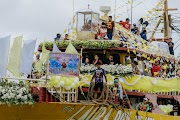Shortly after BAO’s debut, in the time of COVID lockdown and great uncertainty — a majestic mosaic carabao took residency at the front steps of The Negros Museum, an apt home for this symbol of art and culture and the voice of our urban city and rural province.
We wanted an art installation that would ignite the interest and kindle the imagination of its viewers — inspiring more to rediscover the roots and stories embedded and embodied here.
We hope BAO — the unbowed carabao captures the hearts and wild imaginings of local viewers, visiting tourists, resident creatives, and the world at large.
From being our steadfast farming companion, may this vibrant creature become NSC’s voice and presence — sharing thoughtful insights and current updates on relevant and valuable issues and topics.
 |
| BAO installation at The Negros Museum |
Five years later, with 2025 ending — we are reviving and renewing BAO’s presence in the community. An enlivened emblem to the endurance and perseverance of a thriving and evolving culture — rooted in this land of rich and profound bounty.
The oldest evidence of water buffalo discovered in the Philippines is in multiple fragmentary skeletal remains recovered from the upper layers of the Neolithic Nagsabaran site — carbon dated proof of its presence in the Philippines since at least 500 BCE.
Imagine a time lapse covering the years since, encompassing the change this island has undergone — up until this present city that has grown around us. The histories that would be uncovered, the many tales of courage and innovation that have brought us here and now.
How incredible it is that each step along the way our lives and livelihoods have been so closely entwined and carried along on the dependable shoulders of this sturdy draft partner in toil over fields. Cultivating crops, transporting goods, bolstering livelihoods, providing food in its milk and meat, tools and instruments in its bones and horns.
Our carabao has acquired deep cultural significance, becoming a valuable national treasure. As we celebrate the coming months with the season’s harvest, we gather in local food markets and holiday fairs.
Acclaiming the labor of growers who feed us with such care, providing us with fresh produce for our home meals and communal feasts. Food is always central here in our agricultural culture — our lives center around it.
Negros Island is famous for all its special and quality delicacies. Homemade, locally sourced, organically grown, and caringly tended. Food to us is more than vital sustenance. With it we make friends, court loves, and count our blessings.
Our annual farmers fairs are grand crowd drawers — the year end cycle usually starts at the end of September, going on monthly, and peaking in December. Participants come from outlying provinces, towns and barangays of Negros to trade their goods and showcase their products.
Think about the comfort food we grew up around. Is there a dish your lola used to make that takes you back to her kitchen whenever you eat it? Or was there a particular recipe you and your friends loved when you were younger that you always eat when you get together?
Comfort foods keep us happy and contribute to our enjoyment of food. Studies have shown that the comfort foods we desire are ones from our past. They connect us to memories and people gone, returning us to the source of those happier times.
Food is also a great leveler, as a vehicle through which many displaced or in diaspora find refuge. We don’t just imagine but come to embody and emulate what is beloved. Food marks ancestral revolutionary traditions from past to current times — whether as colonized or colonizing peoples.
We can recover and recuperate ways of knowing — of seeing ourselves in futures we have legally, socially, discursively, or materially been excluded from. We can explore ways that help us understand historical and ongoing modes of community building and collaborative survival across home fires and adopted nations.
Originally published at https://baotheunbowed.blogspot.com on October 30, 2025.
Writer: Issa Urra









